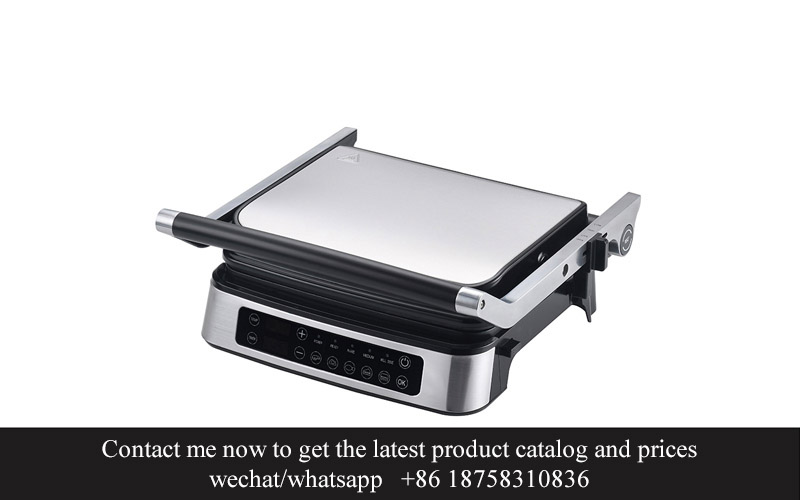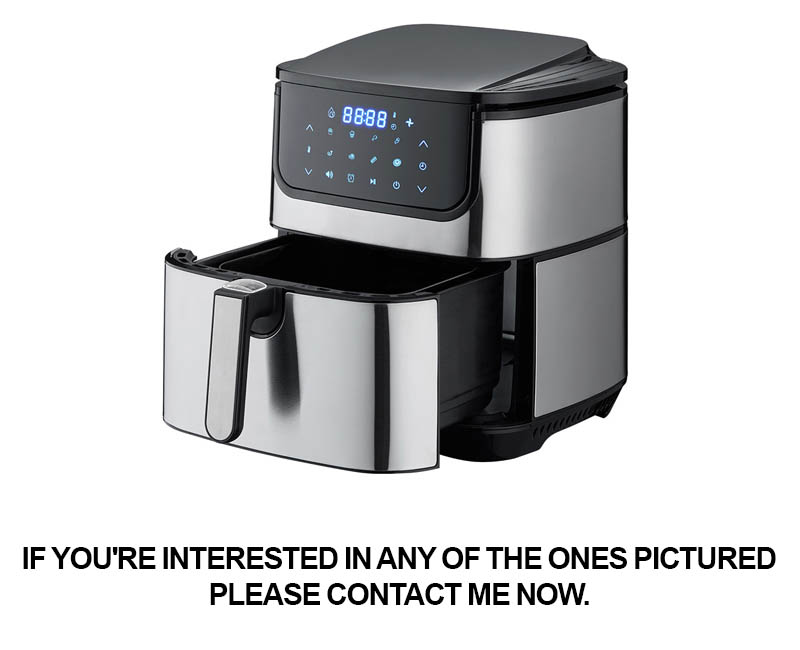Address
304 North Cardinal
St. Dorchester Center, MA 02124
Work Hours
Monday to Friday: 7AM - 7PM
Weekend: 10AM - 5PM
Address
304 North Cardinal
St. Dorchester Center, MA 02124
Work Hours
Monday to Friday: 7AM - 7PM
Weekend: 10AM - 5PM

In the ever-evolving landscape of home appliances, the kitchen has become a hub of innovation and convenience. As we delve into the realm of kitchen appliances, one cannot overlook the significant impact that the latest technologies and designs are having on our daily lives. From sleek cooktops to smart refrigerators, the future of kitchen appliances is shaping up to be a blend of efficiency, sustainability, and cutting-edge features. Join us as we explore the advancements that are transforming the heart of our homes.
The culinary landscape is undergoing a remarkable transformation, with a growing emphasis on health and wellness. As people become more conscious of their dietary choices, the demand for healthy cooking trends has surged. From plant-based diets to low-carb living, here’s a closer look at some of the key trends reshaping the way we cook and eat.
Plant-Based Diets Gain PopularityThe rise of plant-based diets has been nothing short of revolutionary. With the increasing awareness of the environmental impact of meat consumption and the health benefits of a plant-rich diet, more individuals are embracing vegetarian and vegan lifestyles. This shift has led to a surge in plant-based alternatives, including meatless burgers, dairy-free milk, and egg substitutes, all designed to mimic the taste and texture of traditional animal products.
Low-Carb and Ketogenic Diets Take Center StageThe low-carb and ketogenic diets have become mainstream, as people seek to reduce their carbohydrate intake to manage weight and improve health. Foods like avocado, nuts, and seeds have become staples, while traditional carbohydrates such as bread, pasta, and rice have been swapped for high-fiber, low-glycemic options. This trend has spurred innovation in the food industry, leading to a variety of low-carb snacks and baking ingredients.
Fermented Foods Make a ComebackFermented foods, once a staple in many traditional diets, have made a comeback due to their health benefits. Probiotics, the beneficial bacteria found in fermented foods, are known to improve gut health and boost the immune system. Sauerkraut, kimchi, kefir, and yogurt are just a few examples of fermented foods that are gaining popularity among health-conscious consumers.
Superfoods and Functional IngredientsSuperfoods, like kale, quinoa, and turmeric, have long been celebrated for their high nutrient content and health benefits. Now, the trend is expanding to include a wider range of functional ingredients that offer specific health benefits. Ingredients like matcha, spirulina, and maca are being incorporated into everything from smoothies to snack bars, providing a boost of nutrients and antioxidants.
Home Cooking and Meal PreppingAs people become more aware of the quality of the food they consume, there’s been a significant increase in home cooking and meal prepping. Cooking at home allows individuals to control the ingredients and cooking methods, ensuring that meals are fresh, nutritious, and free from additives and preservatives. Meal prep kits and subscription services have also made it easier for busy individuals to maintain a healthy diet without the stress of meal planning.
Digital Nutrition ToolsThe rise of digital technology has brought about a wave of nutrition apps and tools that help individuals make informed dietary choices. These tools can track macronutrient intake, provide nutritional advice, and offer recipes tailored to specific dietary needs. The integration of technology into the cooking and eating experience is making health and wellness more accessible and personalized.
Sustainability and Ethical SourcingConsumers are increasingly concerned about the environmental impact of their food choices. This has led to a trend towards sustainable and ethically sourced ingredients. From organic produce to fair-trade coffee, there’s a growing demand for products that are grown and produced in a way that minimizes harm to the environment and supports local communities.
Food as MedicineThe concept of food as medicine is gaining traction, with more people seeking out foods that can help prevent or treat specific health conditions. Ingredients like turmeric, ginger, and garlic are not only flavorful additions to meals but also have been shown to have anti-inflammatory and other medicinal properties.
The Decline of Processed FoodsThe trend towards healthier eating has also led to a decline in processed foods. People are looking for whole, unprocessed ingredients that provide nutritional value and avoid the high levels of sodium, sugar, and unhealthy fats found in many processed items.
The Rise of Snack CultureWhile health and wellness are at the forefront, the rise of snack culture shows that consumers are still interested in enjoying their favorite flavors in convenient formats. The key is finding snacks that offer balanced nutrition without compromising taste, leading to a growing market for healthy snacks like nuts, seeds, and fruit bars.
In conclusion, the rise of healthy cooking trends reflects a deeper understanding of the connection between diet and health. As these trends continue to evolve, they will likely shape the future of the food industry, leading to more innovative and nutritious options for consumers worldwide.

In today’s fast-paced world, consumers are increasingly aware of the importance of ethical practices, especially when it comes to the products they purchase. This shift in consumer consciousness has led to a surge in demand for products that are manufactured ethically. One such certification that stands out in the kitchen appliance industry is the BSCI (Business Social Compliance Initiative). Here’s a closer look at what BSCI audited standards entail and how they ensure ethical manufacturing.
The BSCI initiative was established in 2003 by a group of European retailers and brands to address social compliance issues in the supply chain. It is a multi-stakeholder initiative that brings together retailers, brands, trade unions, and non-governmental organizations to work towards improving working conditions across the globe. By adhering to BSCI standards, manufacturers commit to upholding human rights, labor laws, and ethical practices in their supply chain.
One of the key aspects of BSCI audited standards is the emphasis on human rights. This includes the right to freedom of association and collective bargaining, as well as the right to a living wage. Manufacturers must ensure that their workers are not subjected to forced labor, child labor, or any form of discrimination. This commitment to human rights is crucial in creating a safe and respectful work environment.
Labor laws are another critical component of BSCI audited standards. This involves compliance with local labor regulations, including working hours, overtime pay, and leaves. Manufacturers must provide fair wages and benefits, ensuring that their employees are not exploited. By adhering to these standards, manufacturers demonstrate their commitment to fair labor practices and contribute to the overall well-being of their workforce.
Health and safety are paramount in the manufacturing process, and BSCI audited standards take this into account. Manufacturers are required to provide a safe working environment, free from hazards and risks. This includes access to clean drinking water, proper sanitation facilities, and adequate ventilation. By prioritizing health and safety, manufacturers not only protect their employees but also uphold their reputation as responsible corporate citizens.
Environmental responsibility is also a cornerstone of BSCI audited standards. Manufacturers must implement environmentally sustainable practices in their operations, reducing waste, energy consumption, and pollution. This includes the use of eco-friendly materials and the promotion of recycling and waste reduction initiatives. By doing so, manufacturers contribute to a greener planet and demonstrate their commitment to environmental stewardship.
Transparency is another key aspect of BSCI audited standards. Manufacturers are required to provide clear and accurate information about their supply chain, including the identification of their suppliers. This transparency ensures that consumers can trust the products they purchase and have confidence in the ethical practices behind their production.
Regular audits are a fundamental part of the BSCI initiative. These audits are conducted by independent third-party organizations to assess compliance with the BSCI code of conduct. These audits are thorough and comprehensive, covering all aspects of the supply chain, from raw material sourcing to final product delivery. The results of these audits are made public, allowing consumers and stakeholders to hold manufacturers accountable for their ethical practices.
The BSCI initiative also promotes continuous improvement. Manufacturers are encouraged to develop and implement action plans to address any identified non-compliance issues. This commitment to improvement ensures that the standards are not just met but exceeded over time.
In conclusion, BSCI audited standards play a vital role in ensuring ethical manufacturing in the kitchen appliance industry. By focusing on human rights, labor laws, health and safety, environmental responsibility, transparency, and continuous improvement, BSCI helps manufacturers create a more ethical and sustainable supply chain. For consumers, this means choosing products that not only meet their needs but also align with their values, fostering a more just and sustainable world.

In the ever-evolving landscape of kitchen appliances, air fryer manufacturers find themselves at the forefront of innovation and consumer demand. Here’s a glimpse into the mindset and strategies of these forward-thinking companies.
Understanding Consumer NeedsManufacturers are acutely aware of the shift towards healthier lifestyles. They’ve noticed the growing preference for low-fat, low-calorie cooking methods, which has propelled the air fryer into the spotlight. This insight has led to a focus on developing products that cater to these health-conscious consumers.
Designing for Efficiency and SafetyThe design process at air fryer manufacturers involves a meticulous balance between efficiency and safety. They invest in research to ensure that their appliances not only cook food to perfection but also do so with minimal energy consumption and maximum safety features. This includes durable materials and easy-to-use interfaces that make cooking a breeze.
Innovation in TechnologyTechnology is a cornerstone of the air fryer manufacturer’s approach. They’re constantly pushing the boundaries of what’s possible with smart features like programmable settings, automatic shut-off, and even connectivity to mobile devices. This not only enhances the user experience but also adds a layer of convenience that keeps customers coming back.
Quality Control and TestingQuality is non-negotiable in the eyes of air fryer manufacturers. They have stringent quality control measures in place to ensure that every unit that leaves the factory meets the highest standards. This includes rigorous testing for durability, performance, and safety, often involving a team of engineers and technicians.
Sustainability and Environmental ResponsibilityModern air fryer manufacturers are also concerned about their environmental footprint. They’re exploring sustainable materials and manufacturing processes that reduce waste and energy consumption. This commitment to sustainability reflects a broader trend in the industry and resonates with eco-conscious consumers.
Adapting to Market TrendsThe market for air fryers is dynamic, and manufacturers must stay ahead of the curve. They monitor emerging trends, such as the demand for healthier oils or compact appliances for smaller kitchens, and adapt their product lines accordingly. This agility allows them to remain competitive in a rapidly changing market.
Customer Feedback and IterationAir fryer manufacturers value customer feedback as a critical component of their product development cycle. They often have dedicated teams that analyze reviews and suggestions, leading to iterative improvements in their products. This customer-centric approach ensures that the end-users receive the best possible appliances.
Collaboration with Industry ExpertsTo stay at the top of their game, manufacturers collaborate with culinary experts, food scientists, and even nutritionists. These partnerships help in understanding the needs of different cooking styles and dietary preferences, ensuring that the air fryers they produce are versatile and suitable for a wide range of users.
Investing in Research and DevelopmentContinuous innovation requires a significant investment in research and development. Air fryer manufacturers are not shy about allocating resources to explore new technologies and cooking methods. This forward-thinking approach keeps them ahead of the competition and ensures that they’re always introducing something new to the market.
Global Expansion and Market DiversificationAs the popularity of air fryers continues to grow, manufacturers are looking beyond their domestic markets. They’re expanding globally and diversifying their product lines to cater to different cultures and cooking traditions. This global perspective is essential for maintaining a strong market presence.
In conclusion, the perspective of air fryer manufacturers is one of innovation, customer focus, and a deep understanding of the market. They’re not just producing appliances; they’re crafting tools that can help people achieve healthier lifestyles in the comfort of their own homes.

The air fryer has emerged as a true game-changer in the kitchen, transforming the way we think about cooking and health. This nifty appliance has garnered a cult following due to its ability to deliver crispy, delicious food with significantly less oil than traditional frying methods. Here’s a closer look at how the air fryer has shaken up the culinary landscape.
The Convenience FactorAir fryers are a breeze to use, making them a hit among busy cooks. Their compact size means they can sit comfortably on any countertop, ready to cook up a storm whenever inspiration strikes. The simple-to-navigate controls and straightforward cooking times have replaced the guesswork that often comes with frying.
Crispness Without the GuiltOne of the most compelling reasons for the air fryer’s popularity is its promise of crispy food with minimal oil. Traditional deep-frying requires a substantial amount of oil to achieve that satisfying crunch, often leading to calorie-heavy meals. The air fryer, on the other hand, uses rapid air circulation to mimic the frying process, resulting in a similar texture with a fraction of the fat content.
Healthier Cooking OptionsThe health benefits of the air fryer are hard to ignore. By using less oil, you can reduce the amount of saturated and trans fats in your diet, which are known contributors to heart disease and other health issues. This doesn’t mean you have to sacrifice taste; the air fryer can make everything from vegetables to chicken to french fries taste like they’ve been dipped in oil, yet they’re much better for you.
Versatility in CookingWhile air fryers are known for their ability to crisp up fried foods, their versatility extends beyond the realm of fried snacks. They can roast, grill, and even bake, offering a wide range of cooking options. This means you can use the air fryer to prepare everything from a healthy dinner to a delectable dessert, all with the same appliance.
Cooking Time and EfficiencyOne of the key selling points of air fryers is the speed at which they cook. Many dishes can be prepared in half the time it takes to cook in the oven or on the stovetop. This efficiency is a game-changer for those who want to enjoy home-cooked meals without spending hours in the kitchen.
Eco-Friendly and SustainableThe reduced need for oil and shorter cooking times also translate to a more sustainable approach to cooking. Using less oil not only benefits your health but also helps reduce the environmental impact of cooking. Additionally, air fryers generally use less electricity than conventional ovens, making them a more eco-friendly option.
Innovation and DesignAs technology advances, air fryers are becoming more sophisticated. Modern models come with features like adjustable temperature settings, programmable timers, and even smart connectivity. These innovations not only enhance the cooking experience but also make the air fryer a more versatile and user-friendly appliance.
Customizable Recipes and TrendsWith the rise of the air fryer, there’s been an influx of creative recipes that showcase the appliance’s capabilities. Chefs and home cooks alike are experimenting with different ingredients and techniques, leading to a wave of new trends in cooking. From gluten-free to low-carb, there’s an air fryer recipe to cater to every dietary preference.
Community and SharingThe air fryer community is thriving, with countless blogs, YouTube channels, and social media groups dedicated to sharing recipes and tips. This collective knowledge base has helped demystify the air fryer and made it accessible to even the most reluctant cooks. The sharing of ideas and experiences has fostered a sense of community among those who love their air fryers.
Maintenance and Clean-UpOne of the standout features of air fryers is their ease of maintenance. The non-stick surfaces and removable baskets make cleaning up a breeze. After a quick wipe down, your air fryer is ready for its next round of culinary magic, making it a convenient and low-maintenance cooking solution.
The air fryer’s impact on the kitchen is undeniable. It’s revolutionized how we approach cooking, offering a healthier, more convenient, and efficient way to prepare food. From the health-conscious home cook to the busy professional, the air fryer has become an essential tool that continues to redefine the art of cooking.

In today’s fast-paced world, the kitchen appliance market is constantly evolving, and manufacturers are striving to offer products that not only cater to convenience but also to innovation and uniqueness. Here’s a glimpse into the world of a manufacturer that prides itself on its distinct offerings.
Our appliances are designed with a focus on functionality and style, ensuring that they not only perform their tasks efficiently but also enhance the aesthetic of any kitchen space. One such standout offering is our sleek and modern induction cooktops, which are not only a visual delight but also a testament to our commitment to energy efficiency.
We understand that every home is different, which is why our collection of compact appliances is tailored to fit the needs of smaller living spaces. Our mini-toaster oven, for instance, is perfect for those who don’t have the room for a full-size oven but still crave the convenience of toasted bread and baked treats.
Innovation isn’t just about new features; it’s about solving problems in unexpected ways. Our smart countertop blender is a prime example. With its intuitive interface and programmable settings, it allows users to effortlessly create a variety of smoothies and recipes, making healthy living easier and more enjoyable.
When it comes to air fryers, our offerings stand out in terms of both performance and design. Our air fryers are engineered with an advanced heating element that ensures even cooking and minimal oil usage, which is a game-changer for health-conscious consumers. The sleek, futuristic design doesn’t just look great—it also takes up less space, making it ideal for urban apartments and smaller kitchens.
We also believe in the power of simplicity, which is why our range of kitchen gadgets includes products like our easy-to-use garlic press and our innovative avocado slicer. These items might seem small, but they make daily cooking tasks a breeze, reducing the stress and time spent in the kitchen.
Our commitment to quality is evident in the materials we use and the craftsmanship that goes into each product. We’ve invested in high-grade stainless steel for our cookware, which not only provides durability but also an elegant look that complements any kitchen decor. The non-stick coatings on our bakeware are free of harmful chemicals, ensuring that our customers can cook with peace of mind.
For those who are passionate about baking, our convection ovens offer the perfect balance of versatility and precision. Whether you’re a novice or a seasoned baker, these ovens can handle a wide range of recipes, from delicate pastries to hearty roasts, all with a professional finish.
We also recognize the importance of safety, especially in the kitchen. Our appliances come with multiple safety features, such as cool-touch handles and childproof locks, which provide peace of mind for busy parents and anyone looking to prevent accidents.
In the world of kitchen appliances, we believe in standing out by offering products that are not just unique but also tailored to the evolving needs of our customers. Our range of pressure cookers, for example, combines the convenience of quick cooking with the health benefits of low-fat cooking, making it a favorite among busy families and health enthusiasts.
Our commitment to innovation extends to our customer service as well. We offer comprehensive support, from detailed user manuals to customer service hotlines, ensuring that our customers have everything they need to make the most of their appliances.
In the end, our unique offerings are more than just products; they’re a reflection of our dedication to creating a better kitchen experience. From the smallest gadget to the most advanced appliance, we aim to provide solutions that make cooking easier, healthier, and more enjoyable.

The air fryer, once a niche appliance, has now become a staple in modern kitchens, transforming the way we approach cooking and health. This game-changer has revolutionized the culinary landscape with its ability to create crispy, delicious fried foods with minimal oil. Here’s a closer look at the impact of the air fryer on our cooking habits and the kitchen environment.
In the past, frying was a popular cooking method, but it came with a health price. High oil content led to calorie-laden dishes, contributing to obesity and other health issues. The air fryer addresses this by using a fan to circulate hot air around food, which cooks it at a lower temperature and requires a fraction of the oil. This innovative approach has won over many health-conscious consumers.
The convenience of the air fryer is undeniable. It’s compact, easy to use, and can quickly cook a variety of foods. From crispy fries to succulent chicken wings, the air fryer has become a go-to for those who want to enjoy their favorite fried treats without the guilt. Its versatility has also expanded to baking, roasting, and even defrosting, making it a versatile addition to any kitchen.
Moreover, the air fryer has sparked a wave of creativity in the culinary world. Chefs and home cooks alike are experimenting with new recipes and flavors, pushing the boundaries of what we thought was possible in a frying appliance. This has led to a surge in unique and health-conscious dishes that are both delicious and satisfying.
One of the most remarkable aspects of the air fryer’s rise is its accessibility. It’s not just a gadget for the health nuts or foodies; it’s for everyone. The affordability of these appliances has made them a staple in households across the globe. No longer do you need to be a professional chef to enjoy the benefits of crispy, golden-brown fried foods.
Safety is another factor that has contributed to the air fryer’s popularity. Traditional deep-frying involves hot oil and a higher risk of burns or fires. The air fryer, on the other hand, operates at a much lower temperature, reducing the risk of accidents. This makes it a safer option for families, especially those with children.
The environmental impact of cooking methods is also a growing concern. The air fryer, with its reduced oil usage, is a more sustainable choice. It helps reduce waste and conserves energy, aligning with the broader trend of eco-friendly living.
As technology advances, manufacturers are continuously improving the air fryer. Features like adjustable temperature controls, automatic shut-off, and pre-programmed settings have made these appliances even more user-friendly. They’re now not just a tool for cooking; they’re a smart appliance that can help streamline kitchen tasks.
The air fryer has also had a positive effect on the foodservice industry. Fast-food chains and restaurants are increasingly offering air-fried options to cater to health-conscious customers. This shift in consumer preference is prompting the industry to reevaluate its offerings and consider healthier alternatives.
The air fryer’s rise is a testament to the power of innovation in the kitchen. It has redefined what it means to cook healthy and delicious food. Whether you’re looking to enjoy your favorite snacks with a clearer conscience or to simplify your cooking routine, the air fryer has proven to be a valuable addition to any kitchen. Its success story is one of technology meeting consumer demand, creating a win-win situation for both health and taste.

In the ever-evolving landscape of the kitchen appliance industry, data-driven insights and industry analysis play a pivotal role in shaping the future of innovation. Here’s an in-depth look into the key findings and trends that are reshaping the market:
The Consumer Shift Towards Smart and Energy-Efficient AppliancesConsumers are increasingly gravitating towards smart kitchen gadgets that not only enhance their culinary experience but also contribute to energy savings and sustainability. The integration of IoT (Internet of Things) technology in appliances has become a norm, allowing for remote control and monitoring.
The Growing Demand for Healthy Cooking OptionsHealth-conscious consumers are driving the market towards healthier cooking alternatives. This shift is evident in the rise of air fryers, induction cooktops, and steam ovens, which offer healthier cooking methods compared to traditional frying or high-heat cooking. Manufacturers are responding by developing appliances that reduce fat content and cooking times.
Emerging Trends in Appliance DesignDesign trends in kitchen appliances are moving towards sleeker, modern aesthetics that blend seamlessly into kitchen decor. The emphasis is not just on functionality but also on style, with appliances featuring minimalist designs and smart features that make them both visually appealing and practical.
The Importance of Customization and PersonalizationCustomization and personalization are becoming more crucial in the appliance market. Consumers are looking for products that can be tailored to their specific needs, whether it’s through adjustable settings, modular components, or the ability to integrate with other smart home devices.
The Role of Sustainability in Appliance DevelopmentSustainability is a key driver in the appliance industry, with manufacturers under pressure to reduce their environmental footprint. This includes the use of recycled materials, energy-efficient designs, and appliances that are designed for longevity to minimize waste.
The Impact of Technology on Appliance FunctionalityTechnological advancements are revolutionizing the functionality of kitchen appliances. Features like touchscreens, voice control, and predictive maintenance are becoming standard, offering users a more intuitive and efficient cooking experience.
Globalization and Its Effects on the Appliance MarketGlobalization has expanded the market reach for kitchen appliances, allowing manufacturers to cater to diverse consumer preferences across different regions. This has led to a more competitive landscape, with companies needing to adapt to varying cultural and economic factors.
The Rise of E-Commerce and Direct-to-Consumer SalesThe growth of e-commerce has changed the way consumers purchase kitchen appliances. Direct-to-consumer sales are on the rise, offering customers a wider range of products and competitive pricing. This shift also allows manufacturers to gather valuable customer data and feedback more directly.
The Future of Appliance Connectivity and AI IntegrationLooking ahead, the integration of AI and connectivity is expected to become even more prevalent. Appliances that can learn from user habits and suggest personalized recipes or cooking times are just around the corner. This level of personalization will further enhance the user experience.
The Role of Social Media and Influencer MarketingSocial media has become a powerful tool for appliance manufacturers to reach consumers. Influencer marketing is particularly effective in showcasing the benefits and unique features of new products, influencing purchasing decisions.
The Challenges of Keeping Up with Technological PaceWhile technological advancements bring opportunities, they also pose challenges. Manufacturers must continually invest in research and development to stay ahead of the curve, ensuring that their products remain competitive and meet evolving consumer needs.
The Importance of Brand Trust and Customer ServiceIn a market where innovation is rapid, brand trust and excellent customer service are paramount. Consumers look for brands that they can rely on, offering reliable products and support when issues arise.
In conclusion, the kitchen appliance industry is undergoing a transformation driven by data-driven insights and industry analysis. By understanding these trends and preferences, manufacturers can better align their product development and marketing strategies to meet the demands of the modern consumer.

In the ever-evolving landscape of kitchen appliances, the air fryer has emerged as a game-changer, transforming the way we cook and eat. This shift has been powered by a surge in technological advancements that have not only improved the functionality of air fryers but also enhanced the user experience. Let’s delve into the role technology plays in the development of air fryers.
The Evolution of Heat DistributionOnce limited to simple, single-basket models, modern air fryers now boast sophisticated heat distribution systems. These systems use multiple fans and heating elements to ensure that the air circulates evenly around the food, leading to more consistent and even cooking. Technology has allowed for the integration of complex algorithms that monitor and adjust the heat levels, reducing the risk of burning and ensuring that every bite is perfectly crispy.
Smart Sensors and User-Friendly InterfacesModern air fryers are equipped with smart sensors that can detect the temperature and humidity of the cooking environment. This technology ensures that the air fryer operates at the optimal temperature for the type of food being cooked, whether it’s a delicate piece of fish or a hearty batch of fries. The user-friendly interfaces, often featuring digital displays and touchscreens, make it easy for anyone to select the right settings and cook times with a simple press of a button.
Programmable Settings and PresetsOne of the standout features of modern air fryers is their programmable settings and presets. Users can now program their air fryer to cook a variety of dishes, from roasted vegetables to chicken wings, with just a few taps. These presets are not just convenient; they are also based on extensive research and testing to ensure the best possible results. Technology has allowed manufacturers to fine-tune these settings to cater to a wide range of preferences and dietary needs.
Energy Efficiency and SustainabilityTechnology has also played a pivotal role in making air fryers more energy-efficient. By optimizing the cooking process and reducing the need for large amounts of oil, air fryers consume less energy than traditional deep fryers. This not only benefits consumers by lowering their utility bills but also contributes to a more sustainable cooking solution. The integration of energy-saving features is a testament to how technology can drive both innovation and environmental responsibility.
Health Monitoring and Nutritional TrackingIn recent years, there has been a growing interest in health and wellness. Air fryer manufacturers have responded by incorporating health monitoring and nutritional tracking into their appliances. Some models can now provide detailed information about the nutritional content of the food being cooked, helping users make more informed choices about their diet. This integration of health technology into kitchen appliances is a clear indication of where the industry is heading.
Safety Features and User AlertsSafety is a top priority in any kitchen appliance, and technology has significantly enhanced the safety features of air fryers. From automatic shut-off functions to non-slip bases and cool-touch handles, these features are designed to prevent accidents and protect users. Additionally, some air fryers now come with user alerts that notify you when the cooking cycle is complete or when the appliance is overheating, providing peace of mind and convenience.
Customization and PersonalizationToday’s air fryers are not just about cooking; they are about personalization. Technology has enabled manufacturers to create air fryers that can be customized to meet individual preferences. From adjustable cooking temperatures to variable cooking times, users can tailor their cooking experience to their specific needs. This level of customization is made possible by the integration of user-friendly technology that allows for easy adjustments and settings.
The integration of technology into air fryer development has been a game-changer for the industry. From the evolution of heat distribution to smart sensors and programmable settings, technology has transformed the air fryer from a simple kitchen gadget into a versatile, efficient, and health-conscious appliance. As technology continues to advance, we can expect even more innovative features that will further enhance the air fryer’s role in modern cooking.

In the world of kitchen appliances, the air fryer has not only become a staple but a game-changer. From families to fitness enthusiasts, this compact cooking gadget has revolutionized the way we approach healthy cooking. Here are a few testimonials and success stories that highlight the positive impact of air fryers in everyday life.
“I was skeptical at first,” said Sarah, a mother of two. “But after using the air fryer, I can confidently say it’s been a game-changer for our family. It’s amazing how we can enjoy crispy, golden fries without the guilt of deep-frying.”
Sarah’s story is echoed by many who have discovered the joy of air-frying. “I used to feel guilty about indulging in my favorite fried foods,” admits Mark, a fitness instructor. “Now, I can have a portion of chicken wings or mozzarella sticks that are delicious and much healthier.”
One of the most compelling success stories comes from Lisa, who has been battling type 2 diabetes. “I was on a strict diet, and cooking at home was challenging,” she recalls. “Then I found the air fryer, and it completely changed my cooking habits. I can now enjoy a variety of foods that I thought were off-limits.”
Lisa’s experience is not unique. Many people with dietary restrictions have found relief in the air fryer’s ability to mimic the taste of fried foods without the high calorie count. “I was able to satisfy my cravings while managing my blood sugar levels,” she says, smiling.
The versatility of air fryers has also made a significant impact on those with busy lifestyles. “I work long hours, and I don’t always have time to cook,” explains Emily, a corporate executive. “The air fryer has been a lifesaver. I can prepare a healthy meal in minutes, which is perfect for my busy schedule.”
Emily’s story is a testament to the convenience that air fryers offer. “I used to rely on frozen, processed meals that were high in sodium and unhealthy fats,” she continues. “With the air fryer, I can now enjoy home-cooked meals that are both delicious and nutritious.”
Success stories also come from the culinary world. Chefs and food enthusiasts have embraced the air fryer as a tool for innovation. “The air fryer has allowed me to experiment with new recipes,” says Chef Alex. “It’s a fantastic way to create crispy textures without the need for excessive oil.”
Chef Alex’s passion for the air fryer has inspired others to explore their culinary creativity. “I’ve tried making everything from breaded fish fillets to air-fried vegetables,” he shares. “The results have been incredible, and I’ve even hosted a few air-frying cooking classes.”
In the realm of environmental consciousness, air fryers have also made their mark. “I was tired of the waste that came with deep-frying,” says Jamie, an eco-conscious consumer. “The air fryer uses less oil and produces fewer emissions, making it a greener option.”
Jamie’s shift to air frying is part of a broader movement towards sustainable living. “I feel good knowing that I’m reducing my carbon footprint while still enjoying my favorite foods,” he says.
As more people discover the benefits of air frying, the community of success stories continues to grow. “It’s amazing how this simple appliance has brought so much joy to my life,” says Tom, a retired chef. “From family gatherings to quiet evenings at home, the air fryer has become a cherished part of our routine.”
Tom’s sentiment resonates with many who have found a new love for cooking and healthy eating through the air fryer. “It’s a reminder that sometimes the best solutions are right under our noses,” he concludes, a smile on his face.

The air fryer’s evolution from a niche kitchen gadget to a staple in many homes is a testament to its versatility and the changing landscape of cooking preferences. It’s a story of how technology has intertwined with culinary desires, leading to a more health-conscious yet convenient cooking experience. As we reflect on the past and look forward to the future, it’s clear that the air fryer’s journey is far from over. Innovations continue to shape its design, functionality, and consumer appeal, promising a future where kitchen appliances are not just tools but companions in our culinary adventures.
The air fryer’s journey began with a simple concept: cooking with less oil while maintaining the crispy texture that many love. It’s now a beacon of technological advancement, with models that boast of smart features like programmable settings, wireless connectivity, and even the ability to track your health. Users have fallen in love with the ability to enjoy fried foods without the guilt, thanks to the air fryer’s ability to mimic the taste and texture of deep-fried dishes with a fraction of the fat.
One of the most remarkable aspects of the air fryer’s popularity is its accessibility. It’s not just a luxury item but a practical one, fitting into a variety of budgets and kitchen sizes. The democratization of cooking has been furthered by the air fryer, making gourmet-style meals accessible to everyone, regardless of their culinary skills.
As we delve into the future, we see a landscape where air fryers are not just cooking devices but part of a larger ecosystem of smart kitchen appliances. Imagine an air fryer that not only cooks but also suggests recipes, keeps track of your dietary goals, and even communicates with your fridge to suggest ingredients based on what you have. The potential for integration with other kitchen tech is vast, and it’s this convergence that will define the future of kitchen appliances.
The air fryer’s success also reflects a broader shift in consumer preferences. There’s a growing demand for health-conscious products that align with a busy lifestyle. People are looking for quick, easy, and nutritious meal options, and the air fryer delivers on all counts. The future will likely see a surge in appliances designed to streamline healthy eating habits, from sous-vide machines that lock in nutrients to ovens that can adjust their settings based on the food being cooked.
Innovation is the driving force behind the air fryer’s evolution, and it’s this same spirit that will propel the future of kitchen appliances. We’re moving away from one-size-fits-all appliances to personalized kitchen tech that adapts to the user’s needs. The air fryer has paved the way for a new era of appliances that are not just efficient but also intuitive.
Sustainability is another key factor shaping the future of kitchen appliances. As environmental concerns grow, manufacturers are under pressure to create products that are not only eco-friendly but also long-lasting. The air fryer’s energy efficiency is a step in the right direction, and we can expect to see more appliances designed with a smaller carbon footprint.
The future of kitchen appliances is also about enhancing the cooking experience. We’re seeing a trend towards appliances that not only cook but also entertain and educate. Imagine a kitchen where your appliances can guide you through a recipe, or where a smart device can offer you cooking tips based on your personal preferences. The kitchen of the future will be a place where technology and tradition blend seamlessly.
In conclusion, the air fryer’s journey is a microcosm of the broader trends in kitchen appliance development. It’s a story of innovation, consumer empowerment, and a focus on health and sustainability. As we move forward, we can expect the kitchen to become a more integrated part of our daily lives, with appliances that not only meet our cooking needs but also enrich our overall experience. The future of kitchen appliances is bright, and the air fryer is just the beginning.